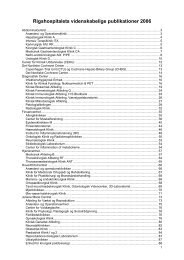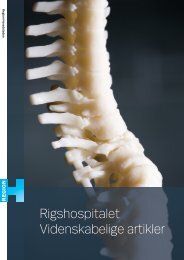View - CTU
View - CTU
View - CTU
You also want an ePaper? Increase the reach of your titles
YUMPU automatically turns print PDFs into web optimized ePapers that Google loves.
ced at both universities in<br />
ins to instrument a molar,<br />
the shaping. To complete<br />
they used at least three<br />
j and seemingly irrational<br />
5ulting in short treatment<br />
1osed by the remuneration<br />
lanish Dental Association<br />
l (where the fixed fee for<br />
rnbly decreased the timesystem<br />
that could give an<br />
n be introduced reflecting<br />
id that the change of the<br />
,d in a reduced number of<br />
~d (Study VI).<br />
al. 1997, Hall et al. 2002, Rater et al. 2002), demonstrates the importance of the<br />
patient-doctor communication, where more patient-centred communication was found<br />
amongst female doctors (Levinson et al. 1997), which might decrease the risk of<br />
becoming involved in liability claims.<br />
A paradox?<br />
The GDPs themselves did not seem to experience sub-optimal root canal treatments<br />
as a problem. Ninety-four per cent regarded their level of endodontic skill as either<br />
excellent or satisfactory (Study V). Moreover, the GDPs had high confidence in<br />
performing endodontic treatments. The endodontic treatment of a mandibular molar<br />
was evaluated with mean values situated in the 'easy' half of the scale (Study II).<br />
This may be due to responder bias, as there may be a discrepancy between what the<br />
health care providers say they perform and document versus what they actually do in<br />
their daily practice (Helminen et al. 2002). However, the GDPs may also have their<br />
focus on illness, as previously discussed. As the focus of the Danish GDPs seems to<br />
be on the presence of clinical symptoms it is speculated that root filling quality is<br />
accepted as long as it prevents such symptoms.<br />
Reflections on hypotheses IV-VI:<br />
The performance of root canal treatments of substandard quality amongst Danish<br />
GDPs may be associated with:<br />
-reports compared to the<br />
, where females tend to<br />
1ate it; moreover females<br />
rankenhaeuser 1993).<br />
for the patient to make a<br />
practice claims, where an<br />
an overrepresentation of<br />
; made by Rene & Owall<br />
111 et al. 1994, Levinson et<br />
0<br />
0<br />
0<br />
0<br />
The use of sub-optimal endodontic routine procedures.<br />
Deficient knowledge of factors important to treatment outcome.<br />
A focus on illness attracting the majority, whereby a high confidence in<br />
performing root canal treatments can be remained.<br />
The presence of a relatively high number of malpractice claims involving<br />
endodontic treatment, as they reflect sub-optimal endodontic treatments due<br />
to technical shortcomings and technical treatment complications.<br />
43








